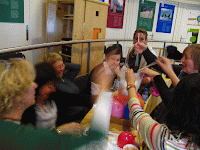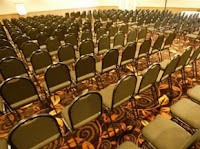 I am currently in the middle of an online sustainability learning project that includes facilitating a number of webinars (10 to be exact) for a big multi-national company with staff based all over the world. For this project, I am one of a distributed delivery team from AtKisson Associates which is located in North America, Europe and Asia, because every module features virtual events in all these three regions. Webinars are the main “person-to-person” component of this programme, so they are the anchor of the learning process (and they need to be good!)
I am currently in the middle of an online sustainability learning project that includes facilitating a number of webinars (10 to be exact) for a big multi-national company with staff based all over the world. For this project, I am one of a distributed delivery team from AtKisson Associates which is located in North America, Europe and Asia, because every module features virtual events in all these three regions. Webinars are the main “person-to-person” component of this programme, so they are the anchor of the learning process (and they need to be good!)
I’ve worked with online learning in the past, such as Horizon Live (an early webinar-like platform, but with no video input or participant audio interactivity possibilities), and even earlier with CD-based, email-mediated distance learning. This is the first real experience I have had faciliting webinars that have so many bells and whistles. For this project, we are using DimDim (http://www.dimdim.com/), which provides the slideshow, chat function, audio for presenters, recording, private chat, whiteboard, video link for the facilitator, and more. For these webinars we are adding the audio interactivity for participants through a call-in conferencing number, which I access by skype.
Needless to say, the first time I facilitated (after a trial run of course) it took me a while to get my head around all the moving parts of this delivery system. At any one moment, I could be presenting slides myself or advancing the slides for a presenter, tracking and answering chat questions, watching myself on video, private chatting to the technology support person in Stockholm, looking for my skype mute button, while trying not to cough or type too loudly, and so on! AND you have to pay attention on top of it, because you are facilitating after all and may need to bring a point back into the discussion later on. (Don’t worry, it gets easier each time to do so many things concurrently – for the video game generation this is probably no big deal.)
I’ve participated in three so far, and during last week’s webinar, anything that could happen seemed to do so technology-wise, testing our creativity, resilience, and Plans B and C on the spot. This morning I facilitated another one, and again, there were multiple, delightful surprises with Dimdim and even Skype at various times within the length of our one-hour event.
Because weird technical things happen during these online sessions, combined with the fact that I need to be fully present in terms of my attention, I find I need to prepare much more than I would have ever imagined prior to this one hour of sitting-at-my-computer facilitation. As a result, I made this checklist for myself – a non-technical checklist for facilitating a webinar. It considers things that I have noticed, about my computer, the content, my environment and myself. With these things ticked off, I am ready for (almost) anything – or at least I am not distracted by things I could have anticipated myself!
Non-technical Webinar Preparation Checklist:
My Computer
There are a number of checks that need to be made on your hardware that is not connected to any particular webinar package. For example:
- (I assume that I have already tested the webinar package and accepted the webinar invitation.)
- Close down all competing open programmes that may be running, and shut down any open documents, except exactly what is needed: internet and skype – (all those extraneous open windows, half written email messages and blog/Twitter/FB/LinkedIn pages need to be shut down/saved)
- Check that the mute button on the computer is not on.
- Unplug the extra monitor, stick to one (nothing more maddening than having to look two places at once on top of everything else).
- Check that headphone/microphone cables are in the right jacks.
- Make sure you have enough money on your skype account.
Content
Whether you are the presenter/facilitator or facilitating another speaker, you will need to be able to anticipate the next slides and have your discussion questions/notes queued up and ready to go.
- Have a copy of the printed slide set in handouts (6 per page – latest version of course).
- DON’T staple (it’s hard to turn pages with one hand on your mouse/keyboard/pen).
- Print slides one sided (as an exception to the rule – turning pages is also noisy).
- Make sure the pages are numbered legibly (so easy to keep in order as you slide them across).
Environment – Ambient Noise
This is critically important, whether you are in a cubicle or a home office – the latter can be even more unpredictable, as is my case. As the facilitator, you have your audio on 99% of the time, so any kind of noise is a big issue.
- Turn your cell phone on vibrate (even if it is across the room).
- Move any other phones like landlines out of the room (they tend to all go off at the same time as someone tries one, and then when you don’t answer it, they try the other).
- Put a DO NOT DISTURB sign on the door (with the time frame of your call).
- Lock the door.
- Tell anyone in the house with a penchant for spontaneous hoovering to wait until after your call (nicely so they don’t decide that they never want to hoover again).
- Let the cat in (especially if it likes to sit outside the office window behind your computer, meows loudly, has incredible persistence and suffers from bad timing).
Environment – Your Office
Managing and preparing the space around you is incredibly important and easy to forget until you are right in the middle of your webinar and shuffling through stacks of stuff looking for a pen.
- Clear the desk from EVERYTHING except your slideset, one note paper and pen (everything else will be in your way at some point).
- Add tissues (seasonal)
- LOOK BEHIND YOU! (Use your video for this -move dead or past-prime plant, coffee cups, extraneous rubbish, strange photos, from view behind you).
- Straighten up any pictures on the wall or put up some visual interest behind you (NOTE Business Idea: Backdrops for webinar presenters that cover messy office spaces and add pleasing, unfussy visual interest. Swiss alps, Tibetan monastery, Carribean beach view.)
You
You and the slideset are the only thing that people are seeing/hearing for an entire hour, have a heart and think about it from their point of view.
- Think about what you are wearing (top half only). Can you add colour, pattern? (Same consideration as for a stand-up facilitator, but from the waist up.)
- Comb hair
- Apply lipstick (or increase your video contrast controls – only half kidding here – nothing like a bland, washed out presenter.)
- Do you need coffee or water on hand?
- Don’t forget the washroom (you won’t be nipping out during the group work on a webinar)
When I first started this checklist, I couldn’t believe how many things needed to be considered prior to facilitating a webinar. I imagined that if I had my slides prepared I could just sit down, plug in and present.
But there is definitely more to it than that – especially if you want to be able to concentrate on the content and dynamics in a virtual environment where you are getting much less sensory input. In this kind of setting many of your facilitator senses are cut off or drastically reduced -you have no sight to speak of and certainly no visual cues on how people are feeling and following. You also have very little hearing, as most of the time participants are on mute until they want to speak, and certainly none of that sixth sense that helps a facilitator in a face-to-face setting read her participants in order to know how and when to engage them and adjust the process to fit their needs.
So for webinar success, increasingly a feature of a facilitator’s work, you need to anticipate and prepare much more than you might expect. Make your own checklist or add to mine – what have I left out?
(For the checklist without the bla, bla, blah, click here: Webinar Facilitators Checklist)
















 8. Test it: Who is the authority who will announce the winner? If appropriate, do you have on hand the “suggested answers” and someone who can explain them?
8. Test it: Who is the authority who will announce the winner? If appropriate, do you have on hand the “suggested answers” and someone who can explain them?









 See Doug Johnson’s
See Doug Johnson’s 






 James Surowiecki has popularized the concept of
James Surowiecki has popularized the concept of 


